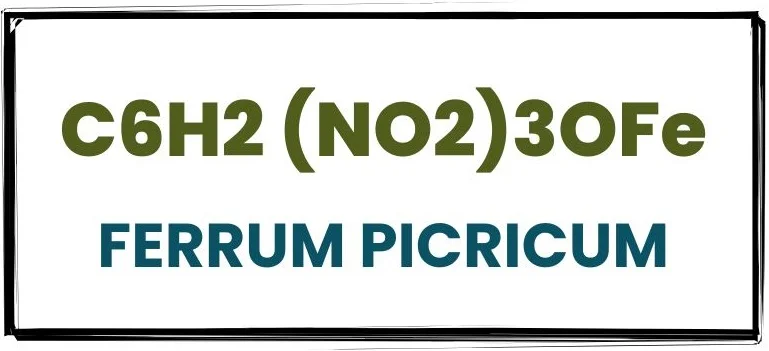Ferrum Picricum, or Picrate of Iron, is a homeopathic remedy used to complement the effects of other medicines, particularly indicated when organ function fails under exertion.
It is most effective in individuals with dark hair, robust constitution, and sensitive livers.
This remedy addresses conditions such as voice failure after public speaking, warts, corns with yellowish discoloration, senile prostate hypertrophy, epistaxis, chronic deafness due to gout, and symptoms resembling pseudo-leukaemia.

Table of Contents
ToggleSOURCE INFORMATION
Origin
- Ferrum Picricum is prepared from Picric Acid and Iron, through a process of trituration and succussion in homeopathic pharmacy.
Historical Facts
- Homeopathic use of Ferrum Picricum is based on its historical application in treating conditions related to impaired organ function under stress or exertion, as well as its specific affinity for dark-haired individuals with liver sensitivity.
DRUG PATHOGENESIS
- Ferrum Picricum acts on conditions where there is a failure of organ function under stress, particularly affecting the voice after public speaking, chronic deafness from gout, and senile hypertrophy of the prostate.
KEY CHARACTERISTICS
- Voice failure after public speaking: Specifically indicated for individuals experiencing voice weakness or hoarseness following speaking engagements.
- Dark-haired patients: Especially effective in individuals with dark hair and plethoric constitution.
- Sensitive liver: Symptoms aggravated by liver sensitivity, manifesting as indigestion, furred tongue, and headaches after meals.
DETAILED ORGAN SYMPTOMS
EARS
- Deafness before menses: Hearing impairment before menstruation.
- Crackling in ears and low-pitched voice: Auditory symptoms accompanied by changes in voice pitch.
- Tinnitus: Humming or ringing in the ears, resembling the sound of telegraph wires.
STOMACH
- Indigestion: Difficulty digesting food, often with a coated tongue and headache post-meals.
- Headache after meals: Especially in bilious (liver-related) individuals with dark hair.
URINARY
- Pain along entire urethra: Discomfort extending along the urinary tract.
- Frequent micturition at night: Increased nighttime urination, with a sensation of fullness and rectal pressure.
- Smarting at neck of bladder and penis: Burning sensation in the urinary tract, reminiscent of Barosma (a remedy for urinary disorders).
- Retention of urine: Difficulty in emptying the bladder completely.
EXTREMITIES
- Pain in right side of neck and down right arm: Pain and discomfort extending from the neck to the arm.
- Locomotor ataxia, ocular stage: Neurological disorder affecting movement and vision.
MODALITIES
- Aggravations: Symptoms worsen under exertion or stress.
- Ameliorations: Conditions improve with rest and quiet.
WHAT ARE MODALITIES IN HOMOEOPATHY?
RELATIONSHIP WITH OTHER DRUGS
- Ferrum Picricum complements the action of other remedies and may be used in conjunction with treatments for conditions like gout, urinary disorders, and chronic organ dysfunctions.
DOSE
- Administered typically in the second and third triturations, in accordance with homeopathic principles.
Frequently Asked Questions
What conditions does Ferrum Picricum treat?
- Ferrum Picricum is indicated for voice failure after public speaking, chronic deafness from gout, urinary issues, and conditions resembling pseudo-leukaemia.
How should Ferrum Picricum be dosed?
- It is typically prescribed in the second or third trituration forms, according to individual symptoms and homeopathic principles.
Meaning of Difficult Words
- Pseudo-leukaemia: A condition resembling leukaemia but not involving malignant cells.
- Epistaxis: Medical term for nosebleed.
- Senile hypertrophy: Enlargement of an organ due to aging.
- Tinnitus: Ringing or buzzing in the ears.
- Locomotor ataxia: A neurological condition affecting movement coordination.
- Bilious: Relating to bile or liver secretions.
- Plethoric: Excessively full of blood.
This comprehensive drug picture of Ferrum Picricum provides insights into its therapeutic indications, historical context, specific symptoms across organ systems, and its use in homeopathic practice.
